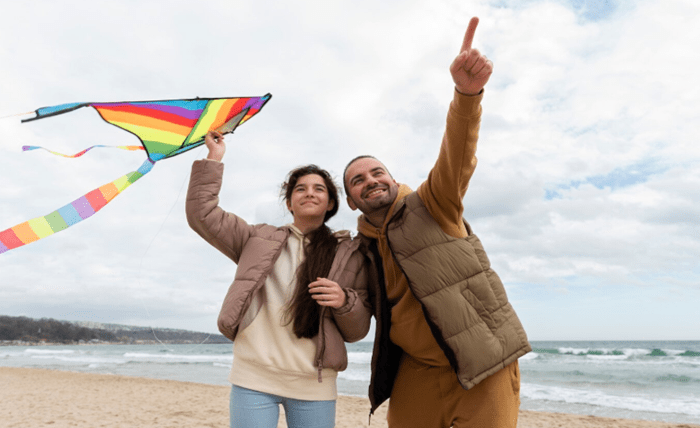If you’ve ever watched someone skimming across the water, kite pulling them forward before launching them sky-high into the air, you know how captivating kite surfing can be. There’s something about the combination of wind, waves, and flight that makes it impossible to look away. And when you’re the one holding the kite, that feeling is multiplied a hundred times over.
Kite surfing (also called kiteboarding) isn’t just another water sport. It’s an experience that blends speed, balance, and freedom in a way few other activities can. Once you try it, you’ll understand why people travel the world just to chase the perfect wind.
So, What Exactly Is Kite Surfing?
Kite surfing is simple in concept: you ride a small board across the water while a large kite catches the wind and pulls you along. The kite is attached to your harness with a control bar, which allows you to steer and adjust power.
The beauty of kite surfing is that you don’t need waves. Flat lagoons, windy bays, wide beaches, and even large lakes are all perfect spots. If there’s enough wind, you can kite surf. This opens up a world of possibilities far beyond traditional surfing locations.
Why It’s So Addictive
There are plenty of water sports that give you a rush, but kite surfing is unique. First, there’s the speed—gliding across the water feels effortless once you’re up and riding. Then there’s the jumps. By using the kite’s power, you can lift off the water and float through the air, sometimes several stories high.
But it’s not just about thrills. Many kite surfers love the quiet moments, like cruising along at sunset or exploring an empty stretch of coastline. It’s a sport you can adapt to your mood—intense and adventurous, or calm and meditative.
The Gear You’ll Use
Kite surfing gear might look a little complex at first, but each piece has a purpose:
- Kite: The wind engine, available in different sizes for varying conditions.
- Control Bar & Lines: This is how you steer and control the power of the kite.
- Harness: Worn around your waist or hips, it attaches you securely to the kite’s pull.
- Board: Beginners usually start with a twin-tip board, similar to a wakeboard.
- Safety Gear: Helmet, flotation vest, and a quick-release system are essential.
If you’re learning, most kite schools provide all the equipment you need. Once you’re hooked, you can invest in your own setup.
How to Learn (and How Long It Takes)
Here’s the truth: kite surfing has a learning curve. This isn’t a sport you can just figure out in an afternoon, but that’s part of what makes it so rewarding.
Your first lesson will probably be on the beach, practicing how to handle the kite. Once you’re comfortable, you’ll move into the water and learn body dragging—using the kite to pull you without the board. After that, you’ll work on water starts, which is when you finally get up and ride.
Most people need several sessions before they can ride on their own. But once you get the hang of it, progress comes fast. One day you’re struggling to stay up; the next, you’re carving turns and riding upwind.
Why It’s Great for Your Body (and Mind)
Kite surfing is an incredible workout, even if it doesn’t feel like one. Balancing on the board engages your legs and core, while steering the kite works your arms and shoulders. You’ll build strength, coordination, and endurance without even thinking about it.
It’s also a fantastic stress reliever. The combination of wind, water, and complete focus pulls you out of everyday worries. When you’re out on the water, the only thing that matters is the kite in the sky and the board beneath your feet.
Where to Go
Kite surfing has gone global, and there’s no shortage of amazing destinations. A few favorites include:
- Tarifa, Spain: Famous for constant wind and a lively kite scene.
- Cape Town, South Africa: Epic for big jumps and dramatic backdrops.
- Le Morne, Mauritius: A tropical paradise with flat lagoons and steady trade winds.
- Cabarete, Dominican Republic: Perfect for both beginners and pros.
- Maui, Hawaii: Kite Beach is a world-class spot for advanced riders.
If you’re just starting, look for locations with shallow water and consistent wind. That makes learning much easier and safer.
Safety Tips
Because the kite is so powerful, safety should always come first. Take proper lessons, check the weather before you go, and never ride in offshore winds (which can push you away from shore). Use your safety gear, know how to release the kite quickly, and give plenty of space to other riders and beachgoers.
Kite surfing can be intense, but if you respect the conditions, it’s very safe.
More Than a Sport
One of the best parts of kite surfing is the community. Beaches with good wind quickly turn into meeting points for riders, and you’ll often see people helping each other launch and land kites. Competitions and festivals add to the culture, but even casual sessions feel social.
For many, kite surfing becomes a lifestyle. It’s about chasing wind forecasts, planning trips around epic destinations, and finding those perfect days on the water that make everything else fade away.
Ready to Try?
If you’re even a little curious, book a lesson at a nearby kite school. You don’t need to be super fit, and you don’t need any experience—just a willingness to learn.
Once you feel that first pull of the kite and start gliding across the water, you’ll understand why so many people fall in love with kite surfing. It’s the closest most of us will ever come to flying, and it’s something you’ll never forget.

